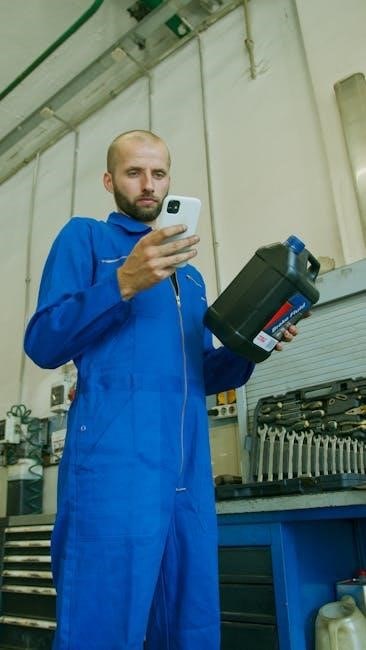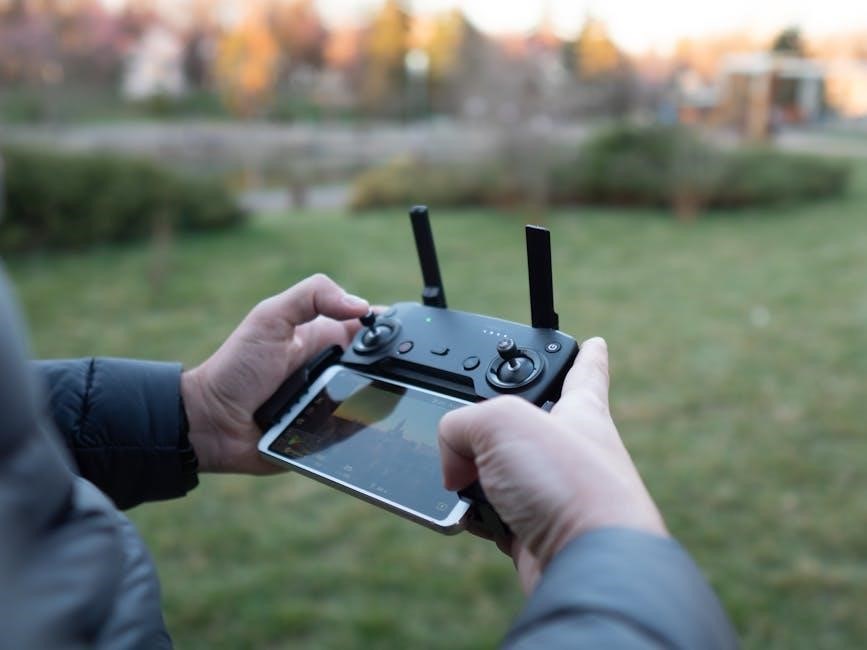
can you remote start a manual
Remote start technology offers convenience by allowing engine ignition without physical key insertion. While popular for automatics, manual transmissions face unique challenges due to safety and gear engagement concerns. Modern systems often require additional sensors and bypass mechanisms to ensure safe operation, making installation more complex but still feasible with compatible aftermarket solutions like Compustar and EasyGuard, which prioritize safety and reliability for manual vehicles.
1.1 What is Remote Start and Its Benefits
Remote start technology allows drivers to ignite their vehicle’s engine from a distance using a remote control or smartphone app. This convenience enhances comfort, especially in extreme weather, by pre-heating or cooling the car. Key benefits include time-saving, reduced effort, and added security, as the vehicle can be started without physical presence. For manual transmissions, compatibility requires specialized systems to ensure safety, but modern solutions like Compustar offer reliable options. Overall, remote start systems provide unparalleled convenience and versatility for drivers seeking to modernize their vehicle’s functionality.
- Convenience in extreme weather conditions.
- Time-saving and reduced physical effort.
- Enhanced security through unattended starting.

1.2 Overview of Manual Transmission Vehicles
Manual transmission vehicles require drivers to manually shift gears using a clutch pedal and gearshift, offering greater control and fuel efficiency. Unlike automatics, manuals demand driver engagement, making them less common but favored by enthusiasts. They are cost-effective and mechanically simpler, yet their popularity has declined due to the convenience of automatics. Despite this, manuals remain relevant, especially for those who enjoy driving dynamics. While remote start installation is more straightforward for automatics, advancements now enable safe remote starting for manuals, addressing unique challenges like neutral gear verification and clutch safety bypasses, ensuring compatibility and safety for these vehicles.

Can You Remote Start a Manual Transmission Vehicle?
Yes, remote starting a manual transmission vehicle is possible with specialized systems like Compustar, but it requires careful installation and specific conditions to ensure safety and functionality.
2.1 Understanding the Challenges
Remote starting a manual transmission vehicle presents unique challenges. Unlike automatics, manuals require the clutch pedal to be pressed for starting, which traditional remote starters can’t bypass. Additionally, safety risks arise if the vehicle isn’t properly secured in neutral gear. Without specialized systems, there’s a danger of the car moving unexpectedly. Moreover, bypassing the clutch safety switch, while possible, can void warranties or cause electrical issues. These challenges make manual transmission vehicles more complex for remote start installations, requiring advanced sensors and mechanisms to ensure safe and reliable operation.
2.2 Safety Considerations
Safety is paramount when remote starting a manual transmission vehicle. The primary concern is ensuring the vehicle remains stationary during startup. If the transmission isn’t securely in neutral or the parking brake isn’t engaged, the car could roll, causing accidents. Additionally, bypassing the clutch safety switch can lead to unintended engine engagement, posing risks of injury or damage. Proper installation of a remote start system is critical to mitigate these risks, ensuring the vehicle is immobilized before ignition. Advanced systems often include fail-safes to detect improper neutral gear positioning or disengaged brakes, enhancing overall safety and reliability for manual transmission vehicles.

Compatible Remote Start Systems for Manual Transmissions
Compustar and EasyGuard systems are top choices for manual transmissions. Compustar’s DAS-II sensor ensures safety, while EasyGuard offers a 2-way alarm with remote start capabilities, enhancing security and convenience.
3.1 Compustar Remote Start Systems
Compustar stands out as a leader in remote start technology, offering compatibility with manual transmission vehicles. Their systems feature the innovative DAS-II Security Sensor, which ensures safe engine starting by verifying the vehicle is in neutral. This sensor addresses the unique challenges of manual transmissions, preventing accidental starts in gear. Compustar’s solutions are designed with safety and reliability in mind, making them a top choice for car owners seeking to add remote start functionality to their manual vehicles without compromising security or performance.

3.2 EasyGuard 2-Way Car Alarm System
The EasyGuard 2-Way Car Alarm System is a versatile solution that combines remote start functionality with advanced security features. Designed to work with manual transmission vehicles, it ensures safe engine ignition by requiring the vehicle to be in neutral gear. The two-way communication feature provides real-time feedback, confirming the car’s status via the remote control. Additionally, the system includes anti-theft alerts, immobilization, and shock sensor capabilities, enhancing overall vehicle security. Its user-friendly interface and robust design make it a popular choice for drivers seeking both convenience and protection for their manual transmission cars.

Installation Requirements for Manual Transmissions
Installing a remote start in a manual requires neutral gear, parking brake, and clutch bypass. Safety sensors and protocols ensure proper function and prevent accidents. Professional installation is recommended.
4.1 Neutral Gear Position
For a manual transmission vehicle, the neutral gear position is essential for remote starting. This ensures the car doesn’t move when started. The vehicle must be securely in neutral, with the parking brake engaged to prevent accidental rolling. Modern remote start systems often include sensors to verify the gear position, adding an extra layer of safety. If the system detects the vehicle is not in neutral, it will not initiate the start. This requirement is critical to avoid potential accidents or damage, making it a fundamental aspect of remote start installation for manual vehicles.
4.2 Parking Brake Engagement
Parking brake engagement is a critical requirement for remote starting a manual transmission vehicle. The system verifies the brake is fully engaged to prevent the car from moving upon startup. Sensors ensure the brake is activated, and the remote start will not function if this condition isn’t met. This safety feature is essential to avoid accidental vehicle movement, especially in manual vehicles, which can roll if not properly secured. Always ensure the parking brake is engaged before using the remote start to maintain safety and prevent potential hazards. This step is a standard requirement for all remote start installations on manual transmissions.
4.3 Bypassing the Clutch Safety Switch
Bypassing the clutch safety switch is necessary for remote starting a manual transmission vehicle. This switch prevents engine startup unless the clutch is pressed, ensuring safety. However, remote start systems require bypassing this feature to allow engine ignition without driver input. Specialized wiring or modules are used to bypass the switch, enabling the remote start to function. This process must be done carefully to avoid safety risks and ensure proper system operation. Bypassing the clutch safety switch is a common requirement for manual vehicles when installing remote start systems, ensuring compatibility and safe operation. Always consult a professional for this process to maintain reliability and avoid potential issues.

Steps to Remote Start a Manual Transmission Vehicle
Remote starting a manual transmission vehicle involves specific steps to ensure safety and functionality. First, ensure the vehicle is in neutral gear and the parking brake is engaged. Next, use the remote starter by pressing the designated button, typically requiring a specific sequence to activate the system. Modern remote start systems for manuals often include safety features that verify the vehicle’s neutral state and parking brake engagement before ignition. Always follow the manufacturer’s instructions for your particular remote start system to ensure proper and safe operation.
5.1 Preparing the Vehicle
Preparing a manual transmission vehicle for remote start requires specific steps to ensure safety and proper functionality. First, shift the vehicle into neutral gear to prevent unintended movement. Next, engage the parking brake to add an extra layer of safety. Additionally, most remote start systems for manual transmissions require bypassing the clutch safety switch, which prevents the engine from starting without the clutch being pressed. It’s crucial to follow the manufacturer’s guidelines for these preparations to avoid any potential risks. Always ensure the vehicle is on level ground and in a secure location before attempting a remote start. Proper preparation ensures reliability and safety for manual vehicles.
5.2 Using the Remote Starter
Using a remote starter on a manual transmission vehicle involves a straightforward process once proper preparations are in place. Press the remote starter button twice with a brief pause in between to activate the system. The vehicle will start only if it detects the transmission is in neutral and the parking brake is engaged. Some systems may require a specific sequence or holding the button longer. After starting, the engine will run until the timer expires or you shut it off. Always verify the vehicle’s status through visual or auditory cues, like blinking lights or horn chirps, before leaving it unattended. Modern systems often include safety rollback features if issues are detected during startup.

Benefits of Remote Start for Manual Vehicles
Remote start offers unmatched convenience, allowing engine ignition without physical keys. Enhanced safety features ensure secure starts, preventing unauthorized use and providing peace of mind for manual vehicle owners.
6.1 Convenience
Remote start technology enhances comfort and accessibility for manual transmission vehicles. Drivers can start their engines from a distance, preheating or cooling the car effortlessly. Compatible systems, like Compustar and EasyGuard, ensure seamless operation, allowing users to lock, unlock, and start their vehicles remotely. This feature is especially beneficial in extreme weather, eliminating the need to physically interact with the car. Additionally, remote start systems often integrate with smartphone apps, offering unparalleled convenience. The ability to warm up the engine or defrost windows before entering the vehicle saves time and improves the overall driving experience, making it a valuable upgrade for manual car owners;
6.2 Added Security Features
Remote start systems for manual transmissions often include advanced security features, enhancing vehicle protection; The EasyGuard 2-Way Car Alarm System, for instance, offers dual-way communication, providing real-time alerts to the user if unauthorized activity is detected. These systems typically include immobilizers, preventing theft even if the vehicle is started remotely. Additional features like shock sensors and anti-theft alerts further deter potential intruders. Compustar systems include a DAS-II Security Sensor, ensuring safe remote starting by verifying the vehicle’s neutral gear position and parking brake engagement. These integrated security measures provide peace of mind, combining convenience with robust protection against theft and unauthorized access for manual transmission vehicles.


Common Concerns and Misconceptions
Many believe manual vehicles can’t use remote start, but modern systems like Compustar and EasyGuard make it possible with proper installation and safety features, addressing common misconceptions about functionality and safety.
7.1 Legal and Insurance Implications
Installing a remote start on a manual vehicle may raise legal and insurance concerns. Some jurisdictions have specific laws regarding remote starters, particularly for manual transmissions, due to potential safety risks if the vehicle isn’t properly secured. Insurance companies may also have restrictions or require proof of a professional installation to maintain coverage. It’s essential to check local regulations and consult with your insurance provider before installing a remote start system on a manual transmission vehicle to ensure compliance and avoid policy issues.
7.2 Maintenance and Reliability
Remote start systems for manual vehicles require regular maintenance to ensure reliability. Proper installation and calibration are crucial to prevent issues like unintended starts or transmission damage. Over time, components such as sensors and bypass modules may need adjustment or replacement. Additionally, extreme weather conditions can affect system performance, so periodic checks are recommended. While modern systems like Compustar are designed for durability, user error, such as forgetting to engage the parking brake, can lead to reliability issues. Consistent upkeep and adherence to manufacturer guidelines help maintain the system’s functionality and safety, ensuring long-term performance without compromising the vehicle’s manual transmission.
Remote starting a manual transmission vehicle is feasible with compatible systems like Compustar, ensuring safety and convenience. Proper installation and precautions are essential for reliable operation.
8.1 Final Thoughts
Remote starting a manual transmission vehicle is indeed possible with the right systems and precautions. While it requires additional safety measures like neutral gear confirmation and clutch bypass, modern technologies such as Compustar and EasyGuard offer reliable solutions. These systems ensure the vehicle starts safely without driver interaction, balancing convenience and security. However, improper installation can lead to risks, so professional expertise is recommended; Overall, remote start technology enhances the driving experience for manual transmission owners, providing comfort and peace of mind without compromising safety. Always prioritize proper installation and follow manufacturer guidelines to maximize benefits and minimize potential issues.